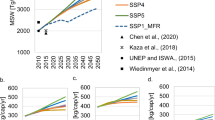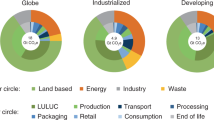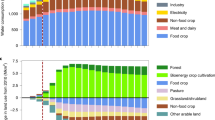Abstract
Global food loss and waste (FLW) undermines the resilience and sustainability of food systems and is closely tied to the United Nation’s Sustainable Development Goals on climate, resource use and food security. Here we reveal strong yet under-discussed interconnections between FLW and two other Sustainable Development Goals of Human Health and Life on Land via the nitrogen cycle. We find that eliminating global FLW in 2015 would have reduced anthropogenic NH3 emissions associated with food production by 11.4 Tg (16%), decreased local PM2.5 concentrations by up to 5 μg m−3 and PM2.5-related years of life lost by 1.5 million years, and mitigated nitrogen critical load exceedances in global biodiversity hotspots by up to 19%. Halving FLW in 2030 will reduce years of life lost by 0.5–0.8 million years and nitrogen deposition by 4.7–6.0 Tg N per year (4%) (range for socioeconomic pathways). Complementary to near-term NH3 mitigation potential via technological measures, our study emphasizes incentivizing FLW reduction efforts from air quality and ecosystem health perspectives.
This is a preview of subscription content, access via your institution
Access options
Access Nature and 54 other Nature Portfolio journals
Get Nature+, our best-value online-access subscription
$29.99 / 30 days
cancel any time
Subscribe to this journal
Receive 12 digital issues and online access to articles
$119.00 per year
only $9.92 per issue
Buy this article
- Purchase on Springer Link
- Instant access to full article PDF
Prices may be subject to local taxes which are calculated during checkout




Similar content being viewed by others
Data availability
The datasets generated or analysed during this study are available in the Mendeley Data repository at https://data.mendeley.com/datasets/jjfg7h8bvd/1 (https://doi.org/10.17632/jjfg7h8bvd.1). The FAOSTAT dataset is publicly available at https://www.fao.org/faostat/en/#home. Source data are provided with this paper.
Code availability
The GEOS-Chem atmospheric chemistry model is available at https://geoschem.github.io/. The GAINS model is available at https://gains.iiasa.ac.at/models/gains_models4.html. The MATLAB codes generated for data analyses and visualization are also available in the Mendeley Data repository at https://data.mendeley.com/datasets/jjfg7h8bvd/1 (https://doi.org/10.17632/jjfg7h8bvd.1).
References
Transforming Our World: The 2030 Agenda for Sustainable Development (United Nations, 2015).
Crippa, M. et al. Food systems are responsible for a third of global anthropogenic GHG emissions. Nat. Food 2, 198–209 (2021).
AQUASTAT: FAO Global Information System on Water and Agriculture (2015); (FAO, accessed October 2022); www.fao.org/aquastat/
Campbell, B. M. et al. Agriculture production as a major driver of the Earth system exceeding planetary boundaries. Ecol. Soc. 22 (2017); https://www.jstor.org/stable/26798991
Liu, X. et al. Strategic thinking on China’s food system transition from perspective of Sustainable Development Goals. Bull. Chin. Acad. Sci. 38, 112–122 (2023) (in Chinese).
Springmann, M. et al. Health and nutritional aspects of sustainable diet strategies and their association with environmental impacts: a global modelling analysis with country-level detail. Lancet Planet. Health 2, e451–e461 (2018).
Zhang, X. et al. Managing nitrogen for sustainable development. Nature 528, 51–59 (2015).
Chang, J. et al. Reconciling regional nitrogen boundaries with global food security. Nat. Food 2, 700–711 (2021).
Springmann, M. et al. Options for keeping the food system within environmental limits. Nature 562, 519–525 (2018).
Gustavsson, J. et al. Global Food Losses and Food Waste—Extent, Causes and Prevention (FAO, 2011).
Creating a Sustainable Food Future. A Menu of Solutions to Sustainably Feed More than 9 Billion People by 2050 (World Resource Institute, 2014).
Law of the People’s Republic of China on Food Waste. The National People’s Congress of the People’s Republic of China http://www.npc.gov.cn/englishnpc/c23934/202112/f4b687aa91b0432baa4b6bdee8aa1418.shtml (2021).
Kummu, M. et al. Lost food, wasted resources: global food supply chain losses and their impacts on freshwater, cropland, and fertilizer use. Sci. Total Environ. 438, 477–489 (2012).
Liu, J. et al. Food losses and waste in China and their implication for water and land. Environ. Sci. Technol. 47, 10137–10144 (2013).
Munesue, Y. et al. The effects of reducing food losses and food waste on global food insecurity, natural resources, and greenhouse gas emissions. Environ. Econ. Policy Stud. 17, 43–77 (2015).
Porter, S. D. et al. A half-century of production-phase greenhouse gas emissions from food loss & waste in the global food supply chain. Sci. Total Environ. 571, 721–729 (2016).
Li, B. et al. Food waste and the embedded phosphorus footprint in China. J. Clean. Prod. 252, 119909 (2020).
Song, G. et al. Food consumption and waste and the embedded carbon, water and ecological footprints of households in China. Sci. Total Environ. 529, 191–197 (2015).
‘World Bank. 2020. Addressing Food Loss and Waste: A Global Problem with Local Solutions. World Bank, Washington, DC. © World Bank. https://openknowledge.worldbank.org/handle/10986/34521 License: CC BY 3.0 IGO.’ (2020).
Hoesly, R. M. et al. Historical (1750–2014) anthropogenic emissions of reactive gases and aerosols from the Community Emissions Data System (CEDS). Geosci. Model Dev. 11, 369–408 (2018).
Pozzer, A. et al. Impact of agricultural emission reductions on fine-particulate matter and public health. Atmospheric Chem. Phys. 17, 12813 (2017).
Guo, Y. et al. Air quality, nitrogen use efficiency and food security in China are improved by cost-effective agricultural nitrogen management. Nat. Food 1, 648–658 (2020).
Megaritis, A. G. et al. Response of fine particulate matter concentrations to changes of emissions and temperature in Europe. Atmospheric Chem. Phys. 13, 3423–3443 (2013).
Pinder, R. W. et al. Environmental impact of atmospheric NH3 emissions under present and future conditions in the eastern United States. Geophys. Res. Lett. 35 L12808, (2008).
Pinder, R. W. et al. Ammonia emission controls as a cost-effective strategy for reducing atmospheric particulate matter in the eastern United States. Environ. Sci. Technol. 41, 380–386 (2007).
Gu, B. et al. Abating ammonia is more cost-effective than nitrogen oxides for mitigating PM2.5 air pollution. Science 374, 758–762 (2021).
WHO global air quality guidelines: particulate matter (PM2.5 and PM10), ozone, nitrogen dioxide, sulfur dioxide and carbon monoxide. World Health Organization https://apps.who.int/iris/handle/10665/345329 (2021).
Global Burden of Disease Study 2019 (GBD 2019) results. Institute for Health Metrics and Evaluation http://ghdx.healthdata.org/gbd-results-tool (2020).
Nilsson, J. et al. in Air Pollution and Ecosystems (ed. Mathy, P.) 85–91 (Springer, 1988).
Lovett, G. M. et al. Critical issues for critical loads. Proc. Natl Acad. Sci. USA 110, 808 (2013).
Hicks, W. K. et al. in Nitrogen Deposition, Critical Loads and Biodiversity (eds. Sutton, M. A. et al.) 1–4 (Springer, 2014).
Reinds, G. J. et al. in Critical Loads and Dynamic Risk Assessments: Nitrogen, Acidity and Metals in Terrestrial and Aquatic Ecosystems (eds. de Vries, W., Hettelingh, J.-P. & Posch, M.) 403–417 (Springer, 2015).
Hettelingh, J. P. et al. Critical load, dynamic modeling and impact assessment in Europe: CCE Status Report 2008, Coordination Center for Effects, Netherlands Environmental Assessment Agency, Bilthoven, Netherlands. Report No. 500090003. ISBN No. 978-90-6960-211-0. EEA https://www.eea.europa.eu/data-and-maps/indicators/exposure-of-ecosystems-to-acidification-2/critical-load-dynamic-modeling-and (2008).
Bouwman, A. F. et al. A global analysis of acidification and eutrophication of terrestrial ecosystems. Water Air Soil Pollut. 141, 349–382 (2002).
Payne, R. J. et al. Impact of nitrogen deposition at the species level. Proc. Natl Acad. Sci. USA 110, 984–987 (2013).
Vira, J. et al. An improved mechanistic model for ammonia volatilization in Earth system models: Flow of Agricultural Nitrogen version 2 (FANv2). Geosci. Model Dev. 13, 4459–4490 (2020).
Riddick, S. N. et al. Estimate of changes in agricultural terrestrial nitrogen pathways and ammonia emissions from 1850 to present in the Community Earth System Model. Biogeosciences 13, 3397–3426 (2015).
Feng, L. et al. The generation of gridded emissions data for CMIP6. Geosci. Model Dev. 13, 461–482 (2020).
Zhang, X. et al. Societal benefits of halving agricultural ammonia emissions in China far exceed the abatement costs. Nat. Commun. 11, 4357 (2020).
Ma, R. et al. Mitigation potential of global ammonia emissions and related health impacts in the trade network. Nat. Commun. 12, 6308 (2021).
Gerten, D. et al. Feeding ten billion people is possible within four terrestrial planetary boundaries. Nat. Sustain. 3, 200–208 (2020).
Aune, D. et al. Fruit and vegetable intake and the risk of cardiovascular disease, total cancer and all-cause mortality—a systematic review and dose-response meta-analysis of prospective studies. Int. J. Epidemiol. 46, 1029–1056 (2017).
Guo, Y. et al. Environmental and human health trade-offs in potential Chinese dietary shifts. One Earth 5, 268–282 (2022).
Wang, M. et al. Accounting for interactions between Sustainable Development Goals is essential for water pollution control in China. Nat. Commun. 13, 730 (2022).
Jägermeyr, J. et al. Reconciling irrigated food production with environmental flows for Sustainable Development Goals implementation. Nat. Commun. 8, 15900 (2017).
Hoehn, D. et al. A critical review on food loss and waste quantification approaches: is there a need to develop alternatives beyond the currently widespread pathways? Resour. Conserv. Recycl. 188, 106671 (2023).
Xue, L. et al. Missing food, missing data? A critical review of global food losses and food waste data. Environ. Sci. Technol. 51, 6618–6633 (2017).
Magalhães, V. S. M. et al. Causes and mitigation strategies of food loss and waste: a systematic literature review and framework development. Sustain. Prod. Consum. 28, 1580–1599 (2021).
Brander, M. et al. Improved on-farm storage reduces seasonal food insecurity of smallholder farmer households—evidence from a randomized control trial in Tanzania. Food Loss Waste Evid. Eff. Policies 98, 101891 (2021).
Attiq, S. et al. Antecedents of consumer food waste reduction behavior: psychological and financial concerns through the lens of the theory of interpersonal behavior. Int. J. Environ. Res. Public Health 18, 12457 (2021).
Min, S. et al. Does dietary knowledge affect household food waste in the developing economy of China? Food Loss Waste Evid. Eff. Policies 98, 101896 (2021).
Three-year action plan to win the battle for a blue sky [in Chinese]. National Development and Reform Commission of the State Council of China http://www.gov.cn/zhengce/content/2018-07/03/content_5303158.htm?gs_ws=weixin_636662351573937202&from=timeline&isappinstalled=0 (2018).
Stokstad, E. et al. Nitrogen crisis threatens Dutch environment—and economy. Science 366, 1180–1181 (2019).
Xue, L. et al. China’s food loss and waste embodies increasing environmental impacts. Nat. Food 2, 519–528 (2021).
Paulot, F. et al. Ammonia emissions in the United States, European Union, and China derived by high‐resolution inversion of ammonium wet deposition data: Interpretation with a new agricultural emissions inventory (MASAGE_NH3). J. Geophys. Res. Atmos. 119, 4343–4364 (2014).
Zhu, L. et al. Global evaluation of ammonia bidirectional exchange and livestock diurnal variation schemes. Atmos. Chem. Phys. 15, 12823 (2015).
Paulot, F. et al. Hidden cost of U.S. agricultural exports: particulate matter from ammonia emissions. Env. Sci. Technol. 48, 903–908 (2014).
Nevison, C. et al. Denitrification, leaching, and river nitrogen export in the Community Earth System Model. J. Adv. Model. Earth Syst. 8, 272–291 (2016).
Fung, K. M. et al. Modeling the interinfluence of fertilizer-induced NH3 emission, nitrogen deposition, and aerosol radiative effects using modified CESM2. Biogeosciences 19, 1635–1655 (2022).
Vira, J. et al. Evaluation of interactive and prescribed agricultural ammonia emissions for simulating atmospheric composition in CAM-chem. Atmos. Chem. Phys. 22, 1883–1904 (2022).
Hurtt, G. C. et al. Harmonization of land-use scenarios for the period 1500–2100: 600 years of global gridded annual land-use transitions, wood harvest, and resulting secondary lands. Clim. Change 109, 117 (2011).
Bey, I. et al. Global modeling of tropospheric chemistry with assimilated meteorology: model description and evaluation. J. Geophys. Res. Atmos. 106, 23073–23095 (2001).
Hu, L. et al. Global simulation of tropospheric chemistry at 12.5 km resolution: performance and evaluation of the GEOS-Chem chemical module (v10-1) within the NASA GEOS Earth system model (GEOS-5 ESM). Geosci. Model Dev. 11, 4603–4620 (2018).
McDuffie, E. E. et al. Source sector and fuel contributions to ambient PM2.5 and attributable mortality across multiple spatial scales. Nat. Commun. 12, 3594 (2021).
Zhai, S. et al. Control of particulate nitrate air pollution in China. Nat. Geosci. 14, 389–395 (2021).
Ackerman, D. et al. Global estimates of inorganic nitrogen deposition across four decades. Glob. Biogeochem. Cycles 33, 100–107 (2019).
Zhao, Y. et al. Atmospheric nitrogen deposition to China: a model analysis on nitrogen budget and critical load exceedance. Atmos. Environ. 153, 32–40 (2017).
Li, M. et al. MIX: a mosaic Asian anthropogenic emission inventory under the international collaboration framework of the MICS-Asia and HTAP. Atmos. Chem. Phys. 17, 935 (2017).
Randerson, J. T. et al. Global Fire Emissions Database, Version 4.1 (GFEDv4). ORNL DAAC https://doi.org/10.3334/ORNLDAAC/1293 (2018).
Xu, W. et al. A database of atmospheric nitrogen concentration and deposition from the nationwide monitoring network in China. Sci. Data 6, 51 (2019).
Hammer, M. S. et al. Global estimates and long-term trends of fine particulate matter concentrations (1998–2018). Environ. Sci. Technol. 54, 7879–7890 (2020).
van Donkelaar, A. et al. Regional estimates of chemical composition of fine particulate matter using a combined geoscience-statistical method with information from satellites, models, and monitors. Environ. Sci. Technol. 53, 2595–2611 (2019).
Zhang, Q. et al. Drivers of improved PM2.5 air quality in China from 2013 to 2017. Proc. Natl Acad. Sci. USA 116, 24463–24469 (2019).
Szopa, et al. in Climate Change 2021: The Physical Science Basis. Contribution of Working Group I to the Sixth Assessment Report of the Intergovernmental Panel on Climate Change (eds. Masson-Delmotte, V. et al.) 817–922 (Cambridge Univ. Press, 2021).
Burnett, R. et al. Global estimates of mortality associated with long-term exposure to outdoor fine particulate matter. Proc. Natl Acad. Sci. USA 115, 9592–9597 (2018).
Zhou, M. et al. Environmental benefits and household costs of clean heating options in northern China. Nat. Sustain. 5, 329–338 (2022).
Vohra, K. et al. Rapid rise in premature mortality due to anthropogenic air pollution in fast-growing tropical cities from 2005 to 2018. Sci. Adv. 8, eabm4435 (2022)
Shaddick, G. et al. Data integration for the assessment of population exposure to ambient air pollution for global burden of disease assessment. Environ. Sci. Technol. 52, 9069–9078 (2018).
Gridded Population of the World, Version 4 (GPWv4): population count adjusted to match 2015 Revision of UN WPP Country Totals, Revision 11. NASA Socioeconomic Data and Applications Center (2018); https://doi.org/10.7927/H4PN93PB
Du, E. et al. Global patterns of terrestrial nitrogen and phosphorus limitation. Nat. Geosci. 13, 221–226 (2020).
Bobbink, R. et al. Effects and Empirical Critical Loads of Nitrogen for Europe. In Critical Loads and Dynamic Risk Assessments (eds de Vries, W., Hettelingh, J. P. & Posch, M.) (Springer Dordrecht, 2015).
Bobbink, R. et al. Global assessment of nitrogen deposition effects on terrestrial plant diversity: a synthesis. Ecol. Appl. 20, 30–59 (2010).
Myers, N. & Mittermeier et al. Biodiversity hotspots for conservation priorities. Nature 403, 853–858 (2000).
Koenig, K. Biodiversity hotspots map (English labels). Zenodo https://zenodo.org/record/4311850#.YbQUsC10cn1 (2016).
Phoenix, G. K. et al. Atmospheric nitrogen deposition in world biodiversity hotspots: the need for a greater global perspective in assessing N deposition impacts. Glob. Change Biol. 12, 470–476 (2006).
Global Modeling and Assimilation Office (GMAO) Modern-Era Retrospective analysis for Research and Applications Version 2 (Goddard Space Flight Center Distributed Active Archive Center (GSFC DAAC), accessed April 2020); https://gmao.gsfc.nasa.gov/reanalysis/MERRA-2/
Lamsal, Lok N. et al. 2021. Ozone Monitoring Instrument (OMI) Aura nitrogen dioxide standard product version 4.0 with improved surface and cloud treatments. Atmos. Meas. Tech. https://doi.org/10.5194/amt-14-455-2021 (2021).
Van Damme, M. et al. Level 2 dataset and Level 3 oversampled average map of the IASI/Metop-A ammonia (NH3) morning column measurements (ANNI-NH3-v2.1R-I) from 2008 to 2016. PANGAEA https://doi.org/10.1594/PANGAEA.894736 (2018).
Amann, M. et al. Environmental improvements of the 2012 Revision of the Gothenburg Protocol. IIASA CIAM Rep. 1, (2012).
Amann, M. et al. Reducing global air pollution: the scope for further policy interventions. Philos. Trans. R. Soc. Math. Phys. Eng. Sci. 378, 20190331 (2020).
Li, J. et al. Spatializing environmental footprint by integrating geographic information system into life cycle assessment: a review and practice recommendations. J. Clean. Prod. 323, 129113 (2021).
Ercsey-Ravasz, M. et al. Complexity of the international agro-food trade network and its impact on food safety. PLoS ONE 7, e37810 (2012).
Acknowledgements
This work is supported by the National Natural Science Foundation of China (41922037 and 71961137011), the PKU-IIASA (International Institute for Applied Systems Analysis) postdoctoral fellowship, International Fellowship for Postdoc Researchers (YJ20210002) and Special Support Fellowship (2022T150005) by China Postdoctoral Science Foundation, and High-performance Computing Platform of Peking University. This work was funded in part by the US Department of Energy (grant no. DE-SC0016361).
Author information
Authors and Affiliations
Contributions
Y.G., G.L. and L.Z. designed the study. Y.G., H.T. and M.Z. performed the research. L.Z., P.G.H., J.V., G.L., Xueying L., Xuejun L. and F.P. contributed data and analytical tools. Y.G., G.L. and L.Z. analysed the results and wrote the manuscript, with valuable suggestions contributed by all other co-authors.
Corresponding authors
Ethics declarations
Competing interests
The authors declare no competing interests.
Peer review
Peer review information
Nature Food thanks Guobao Song and the other, anonymous, reviewer(s) for their contribution to the peer review of this work.
Additional information
Publisher’s note Springer Nature remains neutral with regard to jurisdictional claims in published maps and institutional affiliations.
Supplementary information
Supplementary Information
Supplementary Figs. 1–11 and Tables 1–6.
Source data
Source Data Fig. 1
Raw data for six map contours in Fig. 1.
Source Data Fig. 2
Raw data for one map contour in Fig. 2.
Source Data Fig. 3
Raw data for one map contour in Fig. 3.
Rights and permissions
Springer Nature or its licensor (e.g. a society or other partner) holds exclusive rights to this article under a publishing agreement with the author(s) or other rightsholder(s); author self-archiving of the accepted manuscript version of this article is solely governed by the terms of such publishing agreement and applicable law.
About this article
Cite this article
Guo, Y., Tan, H., Zhang, L. et al. Global food loss and waste embodies unrecognized harms to air quality and biodiversity hotspots. Nat Food 4, 686–698 (2023). https://doi.org/10.1038/s43016-023-00810-0
Received:
Accepted:
Published:
Issue Date:
DOI: https://doi.org/10.1038/s43016-023-00810-0
This article is cited by
-
Ethical Perspectives on Food Morality: Challenges, Dilemmas and Constructs
Food Ethics (2024)



